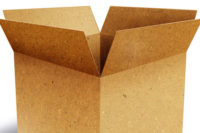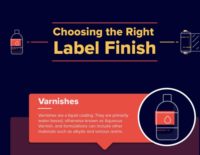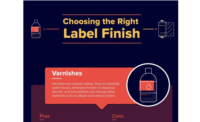The introduction of the first self-sticking label in 1935 created a new exciting market segment for adhesive manufacturers. Since the development, manufacturers have been busy developing a wider range of pressure-sensitive adhesives (PSAs) to better meet specific requirements for a variety of applications. Together, they have produced hundreds of different permanent, removable and repositionable PSAs for coating paper, film, foil and fabric for use in countless end products, such as: postage stamps, safety labels, packaging, clear film laminations, freezer-grade labels, pharmaceuticals, retail price-marking stickers, tapes, bandages, sticky notes and more. These PSA products provide a wide range of properties and performance characteristics, with varying peel, tack and shear strengths, so it’s important for the converter and end user to select the right combination of characteristics for optimum adhesive performance. This article seeks to provide coaters and converters with a basic understanding of pressure sensitive adhesive technology to help them make the optimal choice for their respective tape and label applications.
PSAs are grouped by adhesion type into three basic categories: repositionable, removable and permanent (See Figure 1).
Repositionable PSAs
Repositionable PSAs are the most recent PSA type to make it to market. The first repositionable PSA was created in 1968 and publicly launched with the introduction of the popular sticky note. The repositionable adhesive can be lifted from and reapplied to a surface again and again. It relies upon microsphere technology, which uses larger particles – or spheres – than those typically used in emulsion adhesives. These comparatively large (yet still microscopic) spheres form a discontinuous surface, limiting physical contact that results in low peel and stable tack over time. Conversely, the smaller particles found in typical emulsion polymerized adhesives coalesce into a continuous film that is not repositionable.
Removable PSAs
Removable PSAs have less strength by design and easily peel from the substrate – even after a substantial amount of time – without leaving any adhesive residue on the substrate. Applications for removable labels include masking tape, promotional graphic materials and adhesive bandages. See Table 1 for average application properties for removable PSAs – based on testing data with coater-ready, surfactant-stabilized, acrylic copolymers
Permanent PSAs
Permanent PSAs have maximum strength and cannot be removed from a substrate without damaging the PSA or the substrate itself. Products typically coated with permanent PSAs include safety labels on power equipment, tamper-evident labels and sound-damping films. To put into perspective the power of some of the permanent PSAs: look at some of the ultra-high-performing adhesives that are strong enough to support pounds of weight per square inch, even at higher temperatures. Other PSAs are removable when applied, but gain adhesion over hours or days, to become permanent. See Table 2 for average application properties for permanent PSAs. Specifically, this data is based on testing of coater-ready, surfactant-stabilized, vinyl acrylic copolymers for general-purpose, permanent, p-s adhesives in tape and label applications.
Substrate also a Key Factor
The degree of PSA permanence or removability relies upon both the adhesive strength and the internal strength of the substrate. In other words, a PSA that is easily removed from a substrate for which it’s intended might, in fact, damage a more delicate substrate that requires an adhesive that removes more easily. For example, a removable adhesive that is ideal for stickers on a picture frame might pull the skin off a peach when removed. It is important for the coater or convertor to use the most appropriate PSA for a given substrate and end-use application.
Four Ways to Formulate PSAs
The endless array of PSA formulations, modified to meet the specific requirements of many applications, generally stem from four basic adhesive technologies: solvent-based, UV-curable, water-based or hotmelt PSAs.
Solvent-based PSAs
The adhesives manufacturer dissolves rubber- or acrylic-based resin into an organic solvent. Once the adhesive is coated onto the web, heat and airflow is applied to evaporate the solvent, leaving the dry PSA. Although solvent-based formulations typically offer the highest performance, coaters, converters and end users are moving away from them because they contain heavily regulated VOCs and have a higher carbon footprint. Many are instead turning to environmentally safe water-based products.
UV-Curable PSAs
Developed in the 1960s, ultraviolet-curable adhesives have gained popularity as an environmentally friendly alternative to solvent-based PSAs. They are primarily composed of formulations of silicones, urethanes, acrylics and epoxies. These PSAs are easy to apply and are highly resistant to chemicals, moisture and temperature. They cross-link and cure very rapidly when exposed to a UV light source, eliminating the need for ovens and the expense of operating them. Because they harden quickly, at lower temperatures than other formulations, these versatile PSAs also can be used on heat-sensitive substrates such as plastic films and paper and often are used in electronic, automotive and medical applications.
Water-based formulations
Water-based PSAs are coming into their own thanks to advancements in performance capabilities and the call for environmentally safe and easily handled formulations. In the case of water–based products, adhesives manufacturers produce pressure sensitive polymer emulsions. Once this emulsion is coated on the web, heat and airflow are applied to evaporate the water and create the dry, stickyPSA.
Hot-Melt PSAs
To create hot melt PSAs, adhesives manufacturers combine thermoplastic polymers with tackifying resins and other components (often, aliphatic or aromatic hydrocarbon waxes or plasticizers), heat to a temperature at which the mixture can flow, then package the products. The coater later re-melts the adhesive, which is then coated onto the web and cooled before the web is wound into a roll. Hotmelt formulations typically offer excellent adhesion to substrates and are less expensive than most solvent-based adhesives. However, the high cost of the equipment and energy consumption often deter coaters and converters from using this adhesive technology.
Choosing the Right Adhesive
When evaluating PSAs for a particular application, the coater should look at three primary performance properties: peel, tack and shear.
Peel measures the bond strength between an adhesive and a substrate after pressure is applied and the adhesive has set up by measuring the amount of force needed to pull a strip of tape from a substrate. The test typically is performed at a 90- or 180-degree angle, and peel is measured in units of force per unit width (lb./in. or N/cm.)
Tack is the “stickiness” of the adhesive. It measures the force needed to remove the label and adhesive from a substrate, in units of force (lb. or N). Adhesive manufactures can increase or decrease tack in products.
Shear measures the cohesive strength of the adhesive itself – not the strength of the bond between the adhesive and the substrate. This means the higher the shear strength, the higher the cohesive strength of the polymer.
In order to meet specific applications, adhesive manufacturers vary the amounts of peel, tack and shear. They have developed PSAs that can withstand temperatures well below 0°F to above 200°F. Other adhesive formulations are strong enough to cause damage to a sturdy substrate when lifted, or might be so easy to peel that they can be used on sensitive skin bandages. The industry offers PSAs that meet FDA requirements, become easier to peel over time or that transform from removable to permanent. Some are modified to be ultra-removable, easy to die cut or clear enough to coat on a see-through label for a clear container. There are many different types of PSA products for a broad range of applications and new adhesives are always in development.
The key is for coaters and converters to consider the end use of the tape or label when selecting a PSA. Facestock is as important as the adhesive when adhering a label to a surface with irregular angles; it needs to be flexible, and the adhesive compatible with that material. Highly textured substrates restrict complete contact of the adhesive with the substrate, reducing adhesion, and require more aggressive adhesives or a higher coat weight.
Coaters and converters need to work with adhesive manufacturers to provide the appropriate guidance in PSA selection. Ideally, the adhesives manufacturer should offer easy access to technical support and product testing to ensure that the right formulation, with the appropriate set of physical properties and performance characteristics, is used – and properly applied.
Franklin Adhesives & Polymers
(800) 487-4583
www.franklinadhesivesandpolymers.com







